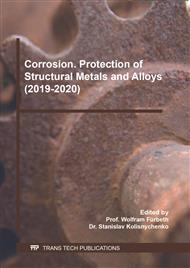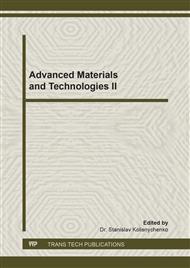[1]
Döner A, Solmaz R, Özcan M, Kardas G. Experimental and theoretical studies of thiazoles as corrosion inhibitors for mild steel in sulphuric acid solution. Corros Sci (2011); 53: 2902–13.
DOI: 10.1016/j.corsci.2011.05.027
Google Scholar
[2]
C. X. Yin et al., Synthesis and Properties of Solidied Inhibitors,, Advanced Materials Research, Vol. 868, pp.624-628, 2014. https://doi.org/10.4028/www.scientific.net/AMR.868.624.
DOI: 10.4028/www.scientific.net/amr.868.624
Google Scholar
[3]
Abbouda Y, Abourriche A, Saffaj T, Berrada M, Charrouf M, Bennamara A, Al Himidi N, Hannache H. 2,3-Quinoxalinedione as a novel corrosion inhibitor for mild steel in 1 M HCl. Mater Chem Phys (2007);105:1–5.
DOI: 10.1016/j.matchemphys.2007.03.037
Google Scholar
[4]
Ansari KR, Quraishi MA. Bis-Schiff bases of isatin as new and environmentally benign corrosion inhibitor for mild steel. J Ind Eng Chem (2014);20:2819–29.
DOI: 10.1016/j.jiec.2013.11.014
Google Scholar
[5]
Elyor Berdimurodov, J Wang, Abduvali Kholikov, Khamdam Akbarov, Bakhtiyor Burikhonov, Nurbik Umirov, Investigation of a New Corrosion Inhibitor Cucurbiturils for Mild Steel in 10% Acidic Medium, Advanced Engineering Forum, Trans Tech Publications, Volume 18, pp.21-38, (2016). https://doi.org/10.4028/www.scientific.net/AEF.18.21.
DOI: 10.4028/www.scientific.net/aef.18.21
Google Scholar
[6]
Karakus N, Sayin K. The investigation of corrosion inhibition efficiency on some benzaldehyde thiosemicarbazones and their thiole tautomers: Computational study. J Taiwan Inst Chem Eng (2014).
DOI: 10.1016/j.jtice.2014.10.024
Google Scholar
[7]
Schmitt G. Application of inhibitors for acid media: Report prepared for the European Federation of Corrosion Working Party on inhibitors. Corros Eng Sci Techn (1984);19:65–176.
DOI: 10.1179/000705984798273100
Google Scholar
[8]
Elyor Berdimurodov, Abduvali Kholikov, Khamdam Akbarov, Innat Nakhatov, Nigora Kh Jurakulova, Nurbek Umirov, Adsorption Isotherm and SEM Investigating of Cucurbit [n] Urils Based Corrosion Inhibitors with Gossypol for Mild Steel in Alkaline Media Containing Chloride Ions, Advanced Engineering Forum, Trans Tech Publications, Volume 23, pp.13-20, (2017). https://doi.org/10.4028/www.scientific.net/AEF.23.13.
DOI: 10.4028/www.scientific.net/aef.23.13
Google Scholar
[9]
Abdallah M, Atwa ST, Salem MM, Fouda AS. Synergistic effect of some halide ions on the inhibition of zinc corrosion in hydrocchloric acid by tetrahydro carbazole derivatives compounds. Int J Electrochem Sci (2013); 8:10001–21.
Google Scholar
[10]
Awad MK, Mustafa MR, Elnga MMA. Computational simulation of the molecular structure of some triazoles as inhibitors for the corrosion of metal surface. J Mol Struct—THEOCHEM (2010);959:66–74.
DOI: 10.1016/j.theochem.2010.08.008
Google Scholar
[11]
Elyor Berdimurodov, Abduvali Kholikov, Khamdam Akbarov, D Nuriddinova, Polarization Resistance Parameters of Anti-Corrosion Inhibitor of Cucurbit [N] Urils and Thioglycolurils in Aggressive Mediums, Advanced Engineering Forum, Trans Tech Publications, Volume 26, pp.74-86, (2018). https://doi.org/10.4028/www.scientific.net/AEF.26.74.
DOI: 10.4028/www.scientific.net/aef.26.74
Google Scholar
[12]
R. He et al., Corrosion Inhibition Effect of PASP and Sulfuric Acid High Cerium on Copper in Citric Acid,, Advanced Materials Research, Vol. 681, pp.3-6, (2013). https://doi.org/10.4028/www.scientific.net/AMR.681.3.
DOI: 10.4028/www.scientific.net/amr.681.3
Google Scholar
[13]
E.T. Berdimurodov., Kh.I. Akbarov, A.J. Kholikov, Physico-chemical investigation of mechanism of inhibition of steel corrosion by thioglycoluril, Universum: Chemistry and Biology, electronic scientific journal, (2018). № 3(45). http://7universum.com/ru/nature/archive/item/5559.
Google Scholar
[14]
Lukovits I, Kalman E, Zucchi F. Corrosion inhibitors—Correlation between electronic structure and efficiency. Corrosion (2001);57:3–8.
DOI: 10.5006/1.3290328
Google Scholar
[15]
Martinez S. Inhibitory mechanism of mimosa tannin using molecular modeling and substitutional adsorption isotherms. Mater Chem Phys (2003);77:97–102.
DOI: 10.1016/s0254-0584(01)00569-7
Google Scholar
[16]
Berdimurodov.E.T, Kh.I. Akbarov, A.J. Kholikov, Investigation new anticorrosion inhibitor 3A, 6A- bistolylthioglycoluril by using of new electrochemical method "Rp/Ec trend, Universum: Technological sciences, electronic scientific journal, (2018). № 2(47). http://7universum.com/ru/tech/archive/item/5539.
Google Scholar
[17]
O.K. Abiola, N.C. Oforka, Adsorption of (4-amino-methyl-5-pyrimidinyl methylthio) acetic acid on mild steel from hydrochloric acid solution (HCl) – Part 1, Mater. Chem. Phys. 83 (2004) 315–322.
DOI: 10.1016/j.matchemphys.2003.10.001
Google Scholar
[18]
Stoyanova A, Petkova G, Peyerimhoff SD. Correlation between the molecular structure and the corrosion inhibiting effect of some pyrophthalone compounds. Chem Phys (2002);279:1–6.
DOI: 10.1016/s0301-0104(02)00408-1
Google Scholar
[19]
Rodrigez-Valdez LM, Martinez-Villafane A, Glossman-Mitnik D. Computational simulation of the molecular structure and properties of heterocyclic organic compounds with possible corrosion inhibition properties. J Mol Struct—THEOCHEM (2005);713:65–70.
DOI: 10.1016/j.theochem.2004.10.036
Google Scholar
[20]
Berdimurodov E., Kholikov A., Akbarov H. Physico-Chemical Study of the Mechanism of Inhibition of the Corrosion of Steel Cucurbit [N] Uriles, Chemical Industry, Teza (Sank-Petersburg), Volume: 95, Number: 1, (2018), Pages: 38-42. https://elibrary.ru/item.asp?id=35290431.
Google Scholar
[21]
Obot IB, Obi-Egbedi NO, Umoren SA. Adsorption characteristics and corrosion inhibitive properties of clotrimazole for aluminium corrosion in hydrochloric acid. Int J Electrochem Sci (2009); 4:863–77.
DOI: 10.1016/j.corsci.2008.11.013
Google Scholar
[22]
Yan Y, Li W, Cai L, Hou B. Electrochemical and quantum chemical study of purines as corrosion inhibitors for mild steel in 1 M HCl solution. Electrochim Acta (2008);53:5953–60.
DOI: 10.1016/j.electacta.2008.03.065
Google Scholar
[23]
Loto RT, Loto CA, Popoola API. Corrosion inhibition of thiourea and thiadiazole derivatives: A review. J Mater Environ Sci (2012);3:885–94.
Google Scholar
[24]
K.R. Ansari, M.A. Quraishi, Experimental and computational studies of naphthyridine derivatives as corrosion inhibitor for N80 steel in 15% hydrochloric acid, Physica E 69 (2015) 322–331.
DOI: 10.1016/j.physe.2015.01.017
Google Scholar
[25]
H. Hamani, T. Douadi, M. Al-Noaimi, S. Issaadi, D. Daoud, S. Chafa, Electrochemical and quantum chemical studies of some azomethine compounds as corrosion inhibitors for mild steel in 1 M hydrochloric acid, Corros. Sci. 88 (2014) 234–245.
DOI: 10.1016/j.corsci.2014.07.044
Google Scholar
[26]
Elyor Tukhliyevich Berdimurodov, Hamdam Ikromovich Akbarov, Abduvali Jonuzakovich Kholikov, Nigora Jurakulova, Adsorption Mechanism Of The Cucurbit [N] Urils On The Mild Steel Surface In 10% Hcl Solution, Conference: World Science: Problems And Innovations, (2017), pp.81-83. https://elibrary.ru/item.asp?id=31250283.
DOI: 10.4028/www.scientific.net/aef.23.13
Google Scholar
[27]
S.A. Abd El-Maksoud, A.S. Fouda, Some pyridine derivatives as corrosion inhibitors for carbon steel in acidic medium, Mater. Chem. Phys. 93 (2005) 84–90.
DOI: 10.1016/j.matchemphys.2005.02.020
Google Scholar
[28]
M. Doddahosuru Gurudatt, K.N. Mohana, Synthesis of new pyridine based 1,3,4-oxadiazole derivatives and their corrosion inhibition performance on mild steel in 0.5 M hydrochloric acid, Ind. Eng. Chem. Res. 53 (2014) 2092–2105.
DOI: 10.1021/ie402042d
Google Scholar
[29]
Elyor Tukhliyevich Berdimurodov, Hamdam Ikromovich Akbarov, Abduvali Jonuzakovich Kholikov, Ulugbek Abdurakhmonovich Khurbanov, Reactivation Studies Of Anticorrosion Inhibitor Of 4, 5-Dihydroxy-4, 5-Bistolylimidazolidine-2-Thione In 5% Hcl Medium, Conference: Modern technologies: current issues, achievements and innovations, (2017), pp.14-16. https://elibrary.ru/item.asp?id=31245802.
Google Scholar
[30]
A. Ghazoui, R. Saddik, N. Benchat, M. Guenbour, B. Hammouti, S.S. AlDeyab, A. Zarrouk, Comparative study of pyridine and pyrimidine derivatives as corrosion inhibitors of C38 steel in molar HCl, Int. J. Electrochem. Sci. 7 (2012) 7080–7097.
DOI: 10.1007/s11164-012-0763-y
Google Scholar
[31]
O. Krim, A. Elidrissi, B. Hammouti, A. Ouslim, M. Benkaddour, Synthesis, characterization, and comparative study of pyridine derivatives as corrosion inhibitors of mild steel in HCl medium, Chem. Eng. Comm. 196 (2009) 1536–1546.
DOI: 10.1080/00986440903155451
Google Scholar
[32]
Elyor Tukhliyevich Berdimurodov, Hamdam Ikromovich Akbarov, Abduvali Jonuzakovich Kholikov, Electrochemical Frequency Modulation Study 3a, 6a-Bistolylthioglycoluril, Conference: Basic and applied research: current issues, achievements and innovations, 2017, pp.54-56. https://elibrary.ru/item.asp?id=30617983.
Google Scholar
[33]
B.D. Mert, A.O. Yüce, G. Kardas , B. Yazıcı, Inhibition effect of 2-amino-4-methylpyridine on mild steel corrosion: experimental and theoretical investigation, Corros. Sci. 85 (2014) 287–295.
DOI: 10.1016/j.corsci.2014.04.032
Google Scholar
[34]
I.B. Obot, Quantum chemical assessment of the interaction of potential anticorrosion additives with steel surface, Innovation Corros. Mater. Sci. 4 (2014) 107–117.
Google Scholar
[35]
H. Behzadi, P. Roonasi, M.J. Momeni, S. Manzetti, M.D. Esrafili, I.B. Obot, M. Yousefvand, S.M.M. Khoshdel, A DFT study of pyrazine derivatives and their Fe complexes in corrosion inhibition process, J. Mol. Struct. 1086 (2015) 64–72.
DOI: 10.1016/j.molstruc.2015.01.008
Google Scholar
[36]
I.B. Obot, S.A. Umoren, Z.M. Gasem, R. Suleiman, B. El Ali, Theoretical prediction and electrochemical evaluation of vinylimidazoline and allylimidazoline as corrosion inhibitors for mild steel in 1 M HCl, J. Ind. Eng. Chem. 21 (2015) 1328–1339.
DOI: 10.1016/j.jiec.2014.05.049
Google Scholar
[37]
E Berdimurodov, A Kholikov, Kh Akbarov, The 4,5-Dihydroxy-4,5-Bistolyl-Imidazolidine-2-Thione (DBIT) As A New Corrosion Inhibitor On Mild Steel In 10% Acidic Medium: By Using The Electrochemical And Scanning Electron Microscope (SEM), ILMIY AXBOROTNOMA, 2017, pp.80-84. http://www.samdu.uz/public/images/ilmiyjurnal/UTE84PZRPZ_ilmiy_jurnal.pdf#page=80.
DOI: 10.4028/www.scientific.net/aef.18.21
Google Scholar
[38]
A. Anejjar, A. Zarrouk, R. Salghi, H. Zarrok, B. Hammouti, B. Elmahi, S. S. Al-Deyab, Studies on the inhibitive effect of the ammonium Iron (II) sulphate on the corrosion of carbon steel in HCl solution, J. Mater. Environ. Sci. 4 (2013) 583–592.
DOI: 10.1007/s11164-012-0892-3
Google Scholar
[39]
G. Golestani, M. Shahidi, D. Ghazanfari, Electrochemical evaluation of antibacterial drugs as environment-friendly inhibitors for corrosion of carbon steel in HCl solution, Appl. Surf. Sci. 308 (2014) 347–362.
DOI: 10.1016/j.apsusc.2014.04.172
Google Scholar



